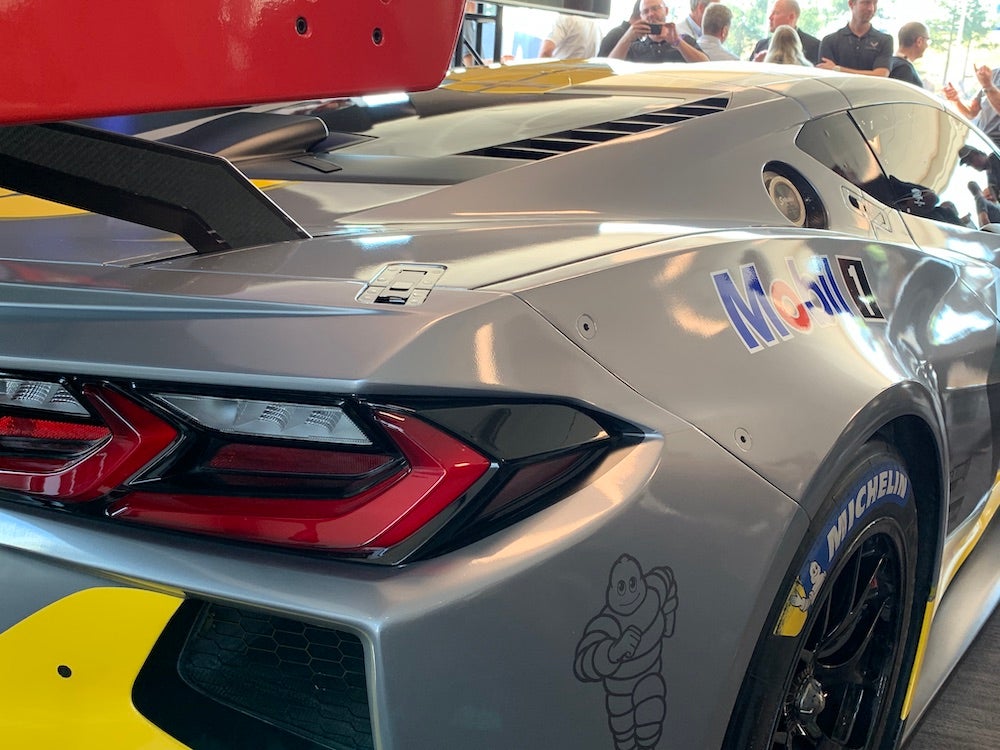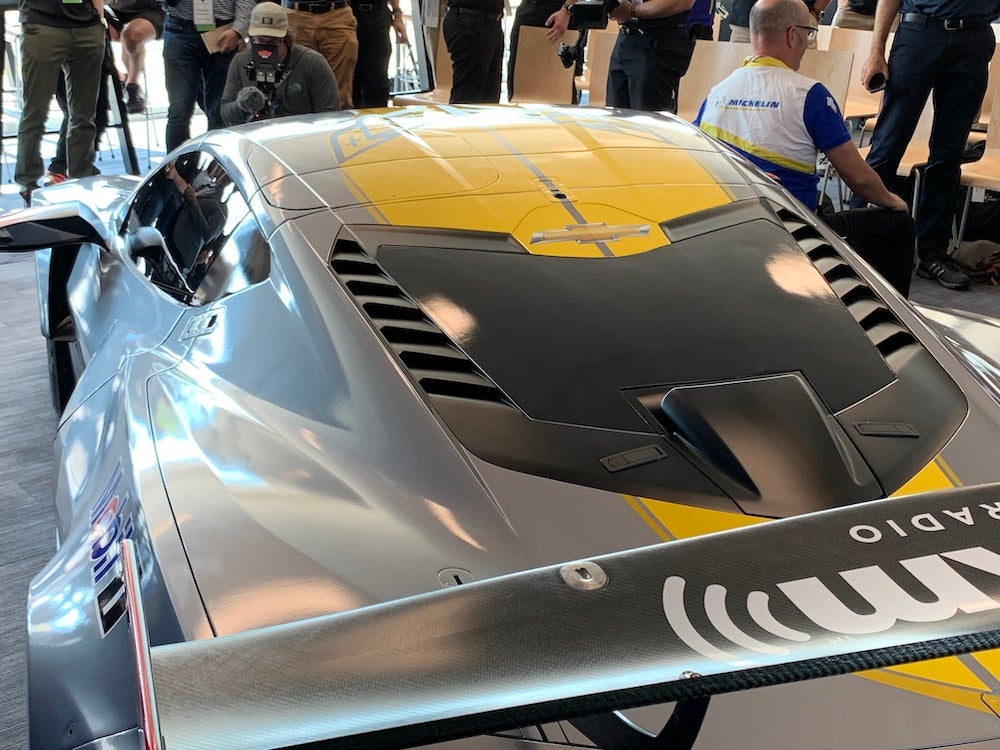Arriving on the heels of its soft debut at the new Corvette convertible launch, Corvette Racing is pulling aside the curtain on its C8.R race car and shedding some of the mysteries surrounding its bananas-sounding engine.
According to Corvette Racing, the C8.R forgoes the road car’s new 495 horsepower 6.2-liter pushrod V8—dubbed the LT2—for a naturally aspirated 5.5-liter DOHC V8 with a flat-plane crankshaft. Though the new engine shares the displacement of the outgoing Pratt & Miller-designed unit, the C8.R’s engine was built in-house by GM Powertrain.
Details are still limited on the exact specifications of the engine outside those detailed above. We asked Chevrolet Racing for more information, such as the weight of the engine, design brief, and whether or not there’s something new the team did to make the engine sound so radically different compared to last season’s C7.R 5.5-liter V8. We’ll update this post when we have that information.
Per IMSA engine rules, the new 5.5-liter V8 produces 500 horsepower and 480 pound-feet of torque. The engine’s oomph is sent through a Corvette-specific compact 6-speed sequential gearbox from Xtrac to the C8.R’s rear wheels. 18-inch Michelin Pilot Sport GT competition tires keep the race car glued to the tarmac.
One interesting factor in the C8.R’s aerodynamics and cooling design is that since the race car doesn’t need a front trunk, or frunk, the Corvette Racing team was able to stick a big ‘ole radiator where that used to be. According to the team, this gives them more freedom in aerodynamic design and a far larger surface area to help cool the high-strung engine. That said, the new mid-engine layout did present some interesting challenges.
The mid-engined layout also pushes the driver's seat forward 16 inches, which allows the racing driver to seat closer to the front axle. According to Corvette Racing driver Tommy Milner, this helps the driver feel the car rotate around them, and therefore diagnose understeer or oversteer faster and more accurately. This not only bridges the gap in terms of competitiveness with Corvette's rivals, but it allows engineers to find an optimum setup for a particular track much faster. If a good setup can be found earlier in the day, it gives the team more time to improve the car during practice and qualifying rather than simply find a baseline setup.
"The main challenge with moving to mid-engine proportions for us was keeping the strong Corvette identity, while advancing the design from the previous generations of the car," C8.R lead exterior engineer Vladimir Kapitonov exclusively told The Drive. "Several strong Corvette cues were employed to achieve this-athletic proportions—lean taught surfacing stretched between character lines, peaked fenders, with driver cockpit set in the middle."
"The main horizontal crease line, piercing the whole body nose-to-tail, recalls significant Corvettes through history, but in a non-literal modern way. Several features make the exterior design uniquely mid-engine: jet-inspired forward-leaning side intake hides the door handle, visually cleaning up the bodyside, vented rear glass shows off the engine like a jewel in a setting. The C8.R racecar presented another challenge for Design. We had to work closely with the race team to retain the character and refinement of the production Corvette, without detriment to race car-specific aerodynamics and on-track performance. We achieved this through iterative surface and livery graphics design process with our partners at Corvette Racing, designers and sculptors working closely with race engineers to create the ultimate expression of a Corvette,” he added.
"It was important for us to develop the new race car alongside the production car, so that each product could properly take advantage of the new architecture," said Corvette’s chief engineer Ed Piatek. "The benefits of this mid-engine supercar, including its incredible balance and connected-to-the-road feel, will be obvious on the street and the track.”
Jim Campbell, Chevrolet’s VP of Performance and Motorsports added: “We have looked forward to racing a production-based mid-engine Corvette for a long time. The debut of the C8.R is the result of immense collaboration between GM Engineering, Propulsion, Design and the Corvette Racing team. As Corvette Racing enters its third decade of competition, we’re excited to begin the next chapter.”
With a new Yellow and Silver livery, the C8.R won’t make its competition debut until the 2020 Rolex 24 at Daytona. However, fans will get a brief glimpse of the race car this upcoming weekend when, according to Chevrolet Racing, “It performs a ceremonial lap on track prior to the 22nd annual Petit Le Mans race” at Road Atlanta Michelin Raceway.
Who’s ready to see the car dice it up with all the Fords, Ferraris, Lamborghinis, Aston Martins, and Porsches? We are.














